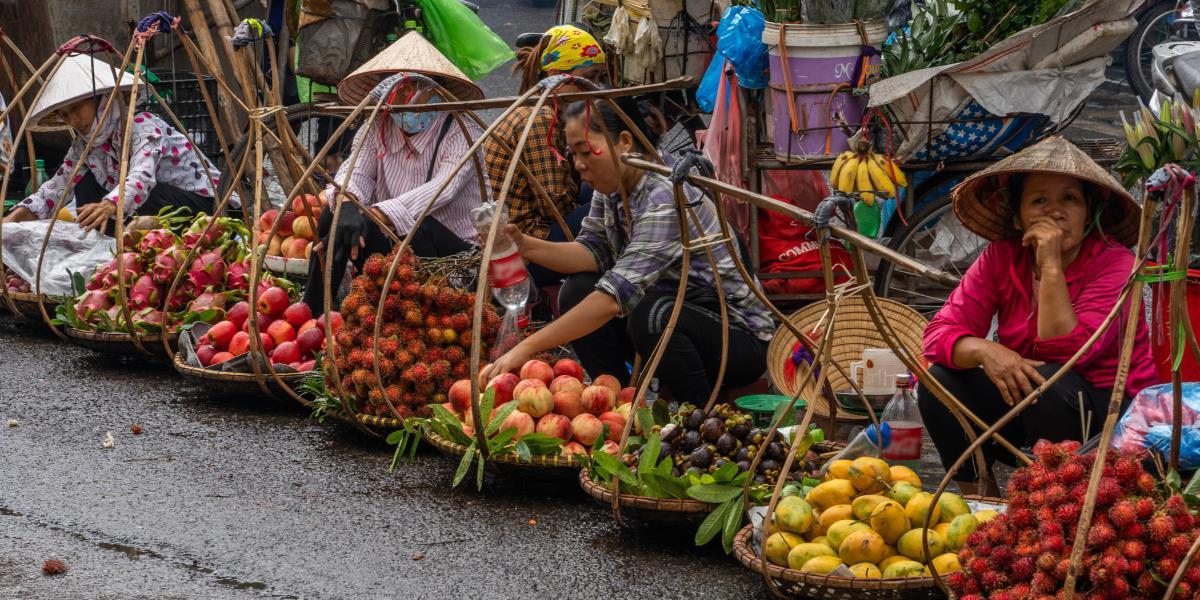Improving Food Safety in Fruit and Vegetable Value Chains in Viet Nam

The increase of pathogenic loads across the value chains—from farm to retail—can be attributed to poor hygienic practices in handling of fruits and vegetables. Photo credit: ADB.
Fruit and vegetables are essential for good health and generate income for millions of smallholder farmers and other value chain actors in Viet Nam. However, consumers tend to reduce intake as they are concerned about food safety. They are mostly worried about pesticide contamination. Many fruits and vegetables in the country are produced with high usage of chemical fertilizers and pesticides.
A study was conducted to assess food safety in fruit and vegetable value chains in Viet Nam based on primary information through laboratory analysis of samples of selected produce and interviews with stakeholders along the value chain.
Results showed that chemical contaminants were not a major risk factor, but foodborne pathogens are a particular concern for leafy vegetables. While the country has made progress on food safety, clear opportunities exist to improve farm management, market infrastructure, and the capacity of food safety authorities.
Primary data were collected from Ha Noi and surrounding areas. Interviews were conducted with farmers, farm input suppliers, government staff, restaurant owners, supermarket owners, and consumers, among others.
A total of 156 samples were tested for microbial contamination (E. coli and Salmonella), 60 samples were analyzed for residues of five commonly used pesticides, 136 samples were analyzed for heavy metals, and 116 samples were analyzed for nitrate.
Pesticide residue analysis was performed at the National Institute for Food Control, while the other contaminants were analyzed at the Department of Food Processing Technology at the Vietnam National University of Agriculture.
E. coli levels. About 31% of the mustard greens samples collected from farms, 67% of samples collected from wholesale markets, and 82% of samples collected from retail market had E. coli loads above maximum permissible levels. The increase of pathogenic loads across the value chains—from farm to retail—can be attributed to poor hygienic practices in handling of fruits and vegetables. However, in the case of cucumber and dragon fruits, E.coli loads are either not detected or remain within maximum permissible levels.
Harmful chemicals. Samples of dragon fruit, mustard greens, and cucumber were also analyzed for five commonly used chemical pesticides, two heavy metals, and nitrate. Pesticide residue above permissible levels was found only in cucumber. No samples had heavy metals and nitrate concentrations above maximum permissible levels.
Government interventions. The Government of Viet Nam has designated areas for safe vegetable production. These areas currently account for about 40% of Ha Noi’s vegetable area of 12,000 hectares. Vegetable farmers in these areas are encouraged to form producer cooperatives. The government regularly tests soil and water quality, and it tests vegetable produce for pesticide residues once a year. Livestock farming is not allowed in these areas to reduce the risk of cross-contamination. These actions contribute to improving the food safety of vegetables to some extent. And they help government agencies to better support smallholder vegetable farmers and monitor the quality of the produce.
Regulatory environment. Over the past decade, Viet Nam has revised its food safety laws and regulations. The existing frameworks are mainly in line with international standards. However, the implementing capacity of government organizations is rather limited to undertake preventive measures.
- Organizing smallholder farmers into groups (producers’ cooperatives) and introducing safe vegetable production areas play a catalytic role in promoting fruit and vegetable safety. This study therefore recommends expanding these practices to other parts of the country.
- Farmers need to be adequately rewarded for safe produce while also subjected to stricter enforcement of existing pesticide regulations. Existing regulations governing pesticide use need to be harmonized. The promotion of safer alternatives to chemical pesticides, such as biopesticides, will also reduce food safety risks. Farmers should be trained in (i) soil fertility management to avoid overuse of fertilizer, (ii) integrated pest and disease management, and (iii) business development to identify new market niches that value quality and safety of food.
- The government and the private sector should work together to better categorize fruits and vegetables based on food safety and other quality aspects. Such segmentation of markets reduces competition that is solely based on price and volume, which is a disincentive for suppliers of high-quality produce. A section of a wet market could be designated as “safe fruits and vegetables,” showing labels and traceability and supported by regular testing.
- At the level of food safety management, there is a need for more systematic testing for contaminants and making test results publicly available, which are necessary to guide investments and regain consumer confidence in food safety. There is also a clear need to strengthen the capacity of food safety authorities, both at the national and subnational levels. Food safety management needs to be guided by a clear understanding of and focus on risk factors, systematic use of data, and shared responsibilities between private and public sector actors, as well as preventive measures implemented along the value chain.
The full report is available at https://www.adb.org/publications/food-safety-fruit-vegetable-value-chains-viet-nam.
Asian Development Bank. 2023. Imperatives for Improvement of Food Safety in Fruit and Vegetable Value Chains in Viet Nam. Manila.
ADB. Regional: Agricultural Value Chain Development in Selected Asian Countries.
This was first posted on Development Asia.
Last Updated: 29 March 2023
